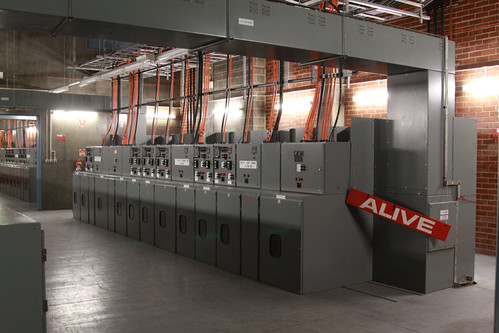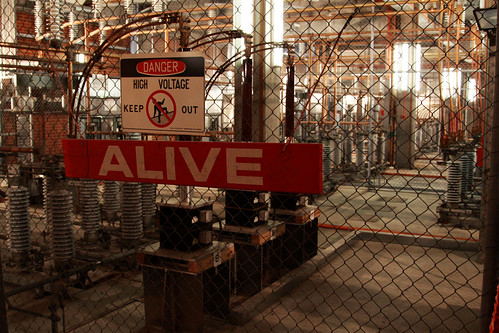Another instalment in my photos from ten years ago series – this time it is July 2010.
Down on Spencer Street
For Melbourne Open House 2010 CitiPower opened ‘JA’ zone substation – a key part of the power supply to the Melbourne CBD.
For historical reasons the substation was divided into two – the State Electricity Commission of Victoria who generated electricity controlled the 66kV input.
While the Melbourne City Council Electrical Supply Department (MCCESD) controlled the 11kV output to consumers.
The operations of the substation were merged following the breakup of the SECV – generation, transmission, distribution and retail being the current segments of the electricity industry.
Outside the substation was a big hole – the site of the former Spencer Street Power Station.
Ready for the ‘Upper West Side’ development, which had already erected an elevated display suite.
The heritage listed cast iron water tank being the only remnant of the old power station.
The $550 million development was completed in 2016, containing 2,207 apartments across four towers.
Trains around Melbourne
Metro Trains Melbourne was busy promising more staff on the network, with ‘despatch paddles’ rolled out at City Loop stations during morning and afternoon peak to indicate that the doors were clear.
But the experiment was short lived – abandoned by 2012.
On 27 July a faulty overhead wire cut power between Southern Cross and Flinders Street stations, severely limiting the amount of trains that could move through that section, and causing crowds across the network.
As ‘compensation’ passengers were given a free travel day on Friday 30 July.
Since then, only the 2016 V/Line VLocity train issues have result in free travel as compensation to passengers.
A happier note was early works for Regional Rail Link, with construction of Southern Cross Station platforms 15 and 16 moving along slowly.
2020 marks five years since V/Line trains from Geelong started using the completed corridor.
And out at the Yarra Valley Railway was an even happier day, with local MP Ben Hardman and Minister for Tourism and Major Events Tim Holding attending the launch of regular heritage train services on the line.
Since then the railway has gone from strength to strength, with government grants allowing the line to be progressively restored from Healesville to Yarra Glen.
V/Line services extended to Maryborough
July 2010 also saw the ribbon being cut on the extension of V/Line rail services from Ballarat to Maryborough. The project was announced in December 2008 as part of the Victorian Transport Plan, at a cost of $50 million.
Public Transport Minister Martin Pakula, Premier John Brumby, and Member for Ballarat East Geoff Howard rode the first train.
Creswick was the only station to be reopened in this first stage, with a new platform constructed opposite the heritage listed buildings.
Clunes following in December 2011.
And Talbot in December 2013.
As part of the project flashing lights and boom barriers were installed at level crossings.
And level crossings on minor roads were closed.
The increasing size of trucks presenting difficulties at other level crossings.
But one unwanted ‘upgrade’ was the removal of passing loops at Sulky, Tourello and Talbot – leaving a 60 kilometre long section of single track between Ballarat and Maryborough, and crippling the ability to run freight services along the corridor.
The recent Murray Basin Rail Project attempted to rectify this at a cost of $440 million, but has left the corridor in even worse condition.
Rail freight
On the standard gauge mainline between Melbourne and Adelaide, a new passing loop was being built outside Lara.
Giving a slight reduction in travel times and increase in efficiency for freight trains on the corridor.
However plenty of freight trains were still being hauled by 60 year old antique locomotives.
Such as those moving grain from the wheat belt.
To the Port of Geelong
The intent of the Murray Basin Rail Project was to convert Victoria’s orphan broad gauge network to standard gauge, allowing the use of locomotives from anywhere in Australia, but with the project stalled, today broad gauge freight services still rely on similarly aged rolling stock.
Finally, I headed out to Waurn Ponds, where loaded cement hoppers were sitting in the sidings ready for despatch.
Alongside B-double cement trucks.
In the end the trucks almost won, with the final cement train ran from Waurn Ponds in December 2015 – but in a surprising move, Qube Logistics returned cement traffic to Victorian tracks in September 2019.
And road freight
‘High Productivity Freight Vehicles’ became widespread at the Port of Melbourne in 2010.
These ‘super’ B-double trucks took the place of port rail shuttles, a project forever proposed but yet to be implemented.
These new bigger trucks serve container parks in the western suburbs of Melbourne, with projects such as the $48.5 million Kororoit Creek Road duplication project in Altona North making road transport more convenient.
Work on the project was completed in December 2011, including the removal of a level crossing on the Werribee line.
Another gift to road freight was the $200 million Anthony’s Cutting upgrade on the Western Freeway between Melton and Bacchus Marsh.
Requiring a massive cutting west of Bacchus Marsh, and new bridges across Djerriwarrh Creek.
The upgraded freeway opened in June 2011, making it even easier for trucks to replace trains on the Melbourne-Adelaide corridor.
One step forwards, two steps back?
Footnote
Here you can find the rest of my ‘photos from ten years ago‘ series.
































You might have covered this but at Clunes ‘they’ made the rather crazy decision to raise the platform in front of the old station building, and demolished and disposed of the historic verandah ! It was eventually replaced with a modern version, stopping short of the edge of course. At Talbot and Creswick new platforms meant no such porblem.
The plan was to restore the veranda, but someone messed up and sent the parts to the scrap yard!
https://www.thecourier.com.au/story/564592/clunes-train-station-historic-verandah-removal-sparks-anger/
V/Line did also offer all travelers on the Gippsland line free travel for about 21 days during October – November 2014.
https://www.gippslandtimes.com.au/story/2652454/free-travel-while-vline-repairs-gippsland-line/
Cranbourne, Pakenham and Gippsland line passengers also got free travel in December 2018 due to level crossing works.
https://www.ptv.vic.gov.au/news-and-events/news/free-travel-on-the-cranbourne-pakenham-and-gippsland-lines-in-december/
[…] time was despatch paddles on the platforms of the busiest stations. As Marcus Wong notes from his equivalent post of photos from July 2010, these were gone by 2012.Also note the people reading real books and newspapers while waiting for […]